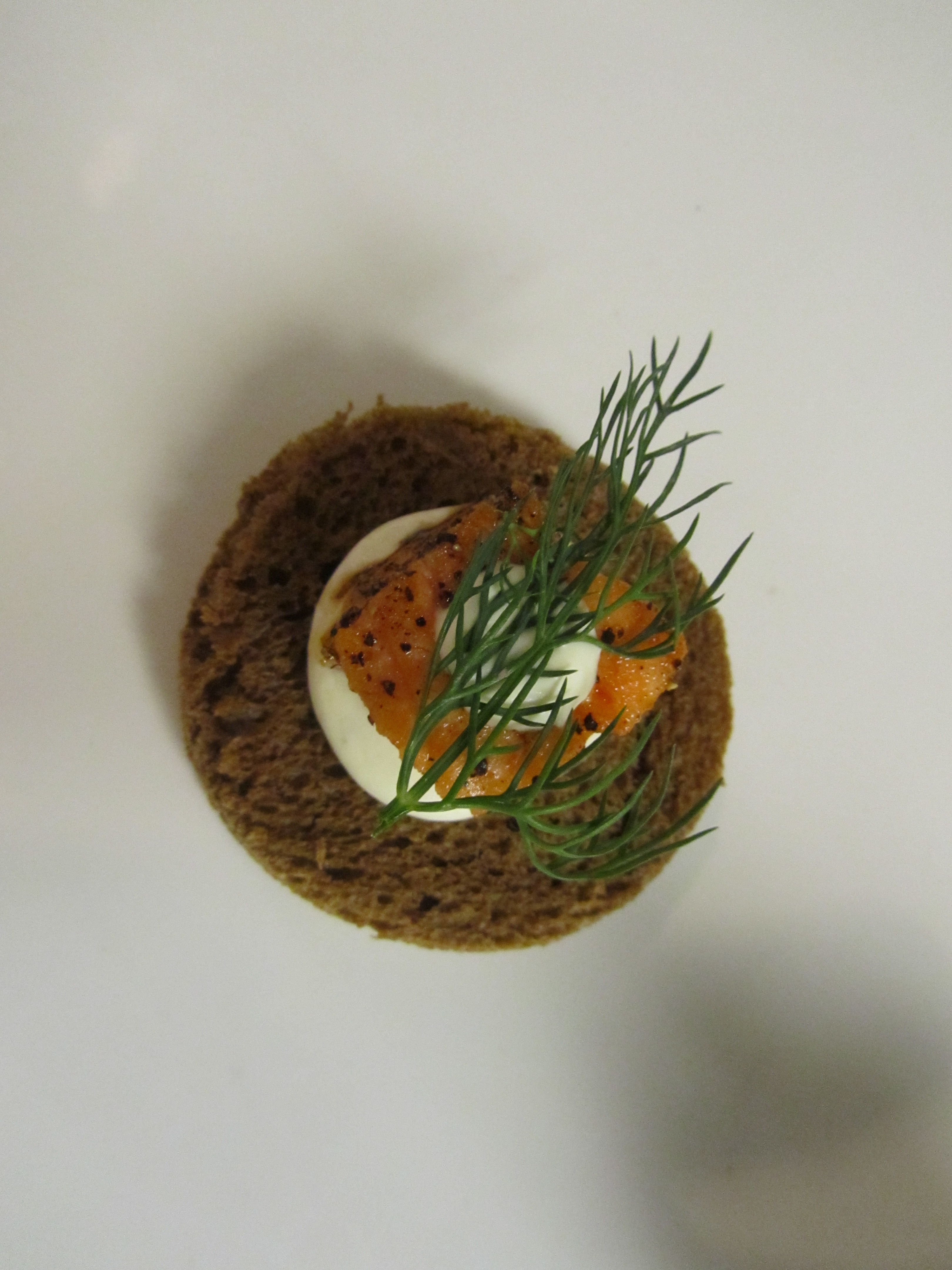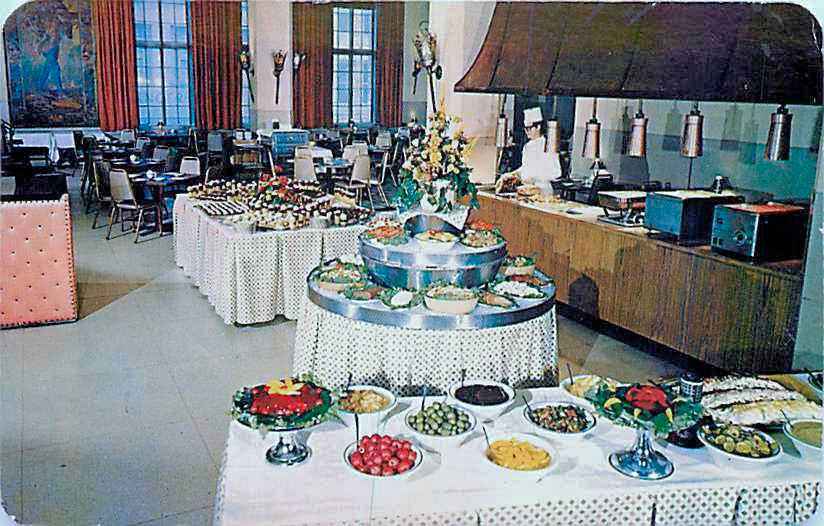|
Full Course Dinner
A full-course dinner is a dinner consisting of multiple dishes, or ''courses''. In its simplest form, it can consist of three or four courses; for example: first course, a main course, and dessert. Basics A multicourse meal or full-course dinner is a meal of multiple courses, almost invariably eaten in the evening or afternoon. Most Western-world multicourse meals follow a standard sequence, influenced by traditional French haute cuisine. Each course is supposed to be designed with a particular size and genre that befits its place in the sequence. There are variations depending on location and custom. The following is a common sequence for multicourse meals: # The meal begins with an hors d'oeuvre or appetizer, a small serving that usually does not include red meat. In Italian custom, ''antipasto'' is served, usually ''finger food'' that does not contain pasta or any starch. # This may be followed by a variety of dishes, including a possible fish course or other light fare. ... [...More Info...] [...Related Items...] OR: [Wikipedia] [Google] [Baidu] |
Dinner
Dinner usually refers to what is in many Western cultures the largest and most formal meal of the day, which is eaten in the evening. Historically, the largest meal used to be eaten around midday, and called dinner. Especially among the elite, it gradually migrated to later in the day over the 16th to 19th centuries. The word has different meanings depending on culture, and may mean a meal of any size eaten at any time of day. In particular, it is still sometimes used for a meal at noon or in the early afternoon on special occasions, such as a Christmas dinner. In hot climates, the main meal is more likely to be eaten in the evening, after the temperature has fallen. Etymology The word is from the Old French () ''disner'', meaning "dine", from the stem of Gallo-Romance ''desjunare'' ("to break one's fast"), from Latin ''dis-'' (which indicates the opposite of an action) + Late Latin ''ieiunare'' ("to fast"), from Latin ''ieiunus'' ("fasting, hungry"). The Romanian word ''deju ... [...More Info...] [...Related Items...] OR: [Wikipedia] [Google] [Baidu] |
Dessert Wine
Dessert wines, sometimes called pudding wines in the United Kingdom, are sweet wines typically served with dessert. There is no simple definition of a dessert wine. In the UK, a dessert wine is considered to be any sweet wine drunk with a meal, as opposed to the white fortified wines ( fino and amontillado sherry) drunk before the meal and the red fortified wines (port and madeira) drunk after it. Thus, most fortified wines are regarded as distinct from dessert wines, but some of the less-strong fortified white wines, such as Pedro Ximénez sherry and Muscat de Beaumes-de-Venise, are regarded as honorary dessert wines. In the United States, by contrast, a dessert wine is legally defined as any wine over 14% alcohol by volume, which includes all fortified wines—and is taxed more highly as a result. This dates back to when the US wine industry only made dessert wines by fortification, but such a classification is outdated now that modern yeast and viticulture can produce dry wi ... [...More Info...] [...Related Items...] OR: [Wikipedia] [Google] [Baidu] |
Oyster
Oyster is the common name for a number of different families of salt-water bivalve molluscs that live in marine or brackish habitats. In some species, the valves are highly calcified, and many are somewhat irregular in shape. Many, but not all oysters are in the superfamily Ostreoidea. Some types of oysters are commonly consumed (cooked or raw), and in some locales are regarded as a delicacy. Some types of pearl oysters are harvested for the pearl produced within the mantle. Windowpane oysters are harvested for their translucent shells, which are used to make various kinds of decorative objects. Etymology The word ''oyster'' comes from Old French , and first appeared in English during the 14th century. The French derived from the Latin , the feminine form of , which is the latinisation of the Ancient Greek () 'oyster'. Compare () 'bone'. Types True oysters True oysters are members of the family Ostreidae. This family includes the edible oysters, which mainly belong t ... [...More Info...] [...Related Items...] OR: [Wikipedia] [Google] [Baidu] |
Canapé
A canapé () is a type of hors d'oeuvre, a small, prepared, and often decorative food, consisting of a small piece of bread (sometimes toasted) wrapped or topped with some savoury food, held in the fingers and often eaten in one bite. Name The name comes from the French word for sofa, drawing on the analogy that the garnish sits atop the bread as people do on a couch. Details Because they are often served during cocktail hours, it is often desired that a canapé be either salty or spicy, in order to encourage guests to drink more. A canapé may also be referred to as finger food, although not all finger foods are ''canapés''. Crackers or small slices of bread or toast or puff pastry are cut into various shapes, used as the base for savory butters or pastes, and often topped with other savory foods such as meat, cheese, fish, caviar, ''foie gras'', purées or relish. Traditionally, ''canapés'' are built on stale bread (although other foods such as puff pastry, crackers ... [...More Info...] [...Related Items...] OR: [Wikipedia] [Google] [Baidu] |
First Class Travel
First class is the most luxurious and most expensive travel class of seats and service on a train, passenger ship, airplane, bus, or other system of transport. Compared to business class and economy class, it offers the best service and most comfortable accommodation. Aviation The First class (aviation), first-class section of a fixed-wing jet airliner is typically toward the front of the aircraft. Many airlines have removed first class altogether from their international flights, offering business class as their highest level of international service. First class passengers are usually allowed into Airport lounge, lounges at airports while they wait for their flights. Railways While first-class travel accommodation is common in intercity public transport rail services, they have become increasingly prevalent for commuters' short-distance daily travel, especially in rapid transit contexts, rather than longer-distance regional rail. Australia Australia has internal rail opera ... [...More Info...] [...Related Items...] OR: [Wikipedia] [Google] [Baidu] |
Amuse-bouche
An ''amuse-bouche'' (; ) or ''amuse-gueule'' (, ; ) is a single, bite-sized'' hors d'œuvre''. Amuse-bouches are different from appetizers in that they are not ordered from a menu by patrons but are served free and according to the chef's selection alone. These are served both to prepare the guest for the meal and to offer a glimpse of the chef's style. The term is French and literally means "mouth amuser". The plural form may be ''amuse-bouche'' or ''amuse-bouches''. In France, is traditionally used in conversation and literary writing, while ''amuse-bouche'' is not even listed in most dictionaries, being a euphemistic hypercorrection that appeared in the 1980s on restaurant menus and used almost only there. (In French, ''bouche'' refers to the human mouth, while ''gueule'' may mean the mouth or snout of an animal, though commonly used for ''mouth'' and derogatory only in certain expressions.) In restaurants The amuse-bouche emerged as an identifiable course during the nouve ... [...More Info...] [...Related Items...] OR: [Wikipedia] [Google] [Baidu] |
Hors D'oeuvres
An hors d'oeuvre ( ; french: hors-d'œuvre ), appetiser or starter is a small dish served before a meal in European cuisine. Some hors d'oeuvres are served cold, others hot. Hors d'oeuvres may be served at the dinner table as a part of the meal, or they may be served before seating, such as at a reception or cocktail party. Formerly, hors d'oeuvres were also served between courses.''Oxford English Dictionary'', First Edition, 189''s.v.''/ref> There are two types of hors d'oeuvre from service point of view: # General hors d'oeuvre # Classical hors d'oeuvre General hors d'oeuvres include cold preparations such as salad, cold meat, and fish. Classical hors d'oeuvres include fruit juice and soft drinks, grapefruit, shellfish cocktail, and so on. Typically smaller than a main dish, an hors d'oeuvre is often designed to be eaten by hand. Etymology in French literally means "outside the work"; that is, "not part of the ordinary set of courses in a meal". In practice, it is a ... [...More Info...] [...Related Items...] OR: [Wikipedia] [Google] [Baidu] |
Appetizer
An hors d'oeuvre ( ; french: hors-d'œuvre ), appetiser or starter is a small dish served before a meal in European cuisine. Some hors d'oeuvres are served cold, others hot. Hors d'oeuvres may be served at the dinner table as a part of the meal, or they may be served before seating, such as at a reception or cocktail party. Formerly, hors d'oeuvres were also served between courses.''Oxford English Dictionary'', First Edition, 189''s.v.''/ref> There are two types of hors d'oeuvre from service point of view: # General hors d'oeuvre # Classical hors d'oeuvre General hors d'oeuvres include cold preparations such as salad, cold meat, and fish. Classical hors d'oeuvres include fruit juice and soft drinks, grapefruit, shellfish cocktail, and so on. Typically smaller than a main dish, an hors d'oeuvre is often designed to be eaten by hand. Etymology in French literally means "outside the work"; that is, "not part of the ordinary set of courses in a meal". In practice, i ... [...More Info...] [...Related Items...] OR: [Wikipedia] [Google] [Baidu] |
à La Carte
In restaurants, ''à la carte'' (; )) is the practice of ordering individual dishes from a menu in a restaurant, as opposed to ''table d'hôte'', where a set menu is offered. It is an early 19th century loan from French meaning "according to the menu".''Oxford English Dictionary'' The individual dishes to be ordered may include side dishes, or the side dishes may be offered separately, in which case, they are also considered ''à la carte''. History The earliest examples of ''à la carte'' are from 1816 for the adjectival use ("à la carte meal", for example) and from 1821 for the adverbial use ("meals were served à la carte"). These pre-date the use of the word menu, which came into English in the 1830s."Menu"''The American Heritage Dictionary of the English Language'' 4th edition, Houghton Mifflin See also * Omakase, Japanese expression for letting the chef decide * ''Table d'hôte'', the opposite of ''à la carte'' * Buffet * List of French words and phrases used by ... [...More Info...] [...Related Items...] OR: [Wikipedia] [Google] [Baidu] |
12 Course Table Setting
1 (one, unit, unity) is a number representing a single or the only entity. 1 is also a numerical digit and represents a single unit of counting or measurement. For example, a line segment of ''unit length'' is a line segment of length 1. In conventions of sign where zero is considered neither positive nor negative, 1 is the first and smallest positive integer. It is also sometimes considered the first of the infinite sequence of natural numbers, followed by 2, although by other definitions 1 is the second natural number, following 0. The fundamental mathematical property of 1 is to be a multiplicative identity, meaning that any number multiplied by 1 equals the same number. Most if not all properties of 1 can be deduced from this. In advanced mathematics, a multiplicative identity is often denoted 1, even if it is not a number. 1 is by convention not considered a prime number; this was not universally accepted until the mid-20th century. Additionally, 1 is the s ... [...More Info...] [...Related Items...] OR: [Wikipedia] [Google] [Baidu] |
Buffet
A buffet can be either a sideboard (a flat-topped piece of furniture with cupboards and drawers, used for storing crockery, glasses, and table linen) or a system of serving meals in which food is placed in a public area where the diners serve themselves. A form of ''service à la française'', buffets are offered at various places including hotels, restaurants, and many social events. Buffet restaurants normally offer all-you-can-eat food for a set price, but some measure prices by weight or by number of dishes. Buffets usually have some hot dishes, so the term cold buffet (see Smörgåsbord) has been developed to describe formats lacking hot food. Hot or cold buffets usually involve dishware and utensils, but a finger buffet is an array of foods that are designed to be small and easily consumed only by hand, such as cupcakes, slices of pizza, foods on cocktail sticks, etc. The essential feature of the various buffet formats is that the diners can directly view the food and imm ... [...More Info...] [...Related Items...] OR: [Wikipedia] [Google] [Baidu] |
Service à La Française
(; "service in the French style") is the practice of serving various dishes of meal at the same time, with the diners helping themselves from the serving dishes. That contrasts to (; "service in the Russian style") in which dishes are brought to the table sequentially and served individually, portioned by servants. Formal dinners were served ''à la française'' from the Middle Ages to the 19th century, but in modern times it has been largely supplanted by ''service à la russe'' in restaurants. ''Service à la française'' still exists today in the form of the ''buffet'', and remains popular for small and large gatherings in homes, companies, hotels, and other group settings. It is also similar to the Chinese style of serving large groups in many Chinese restaurants. There was a less formal style known as (; "English service") in France, with the hostess serving out the soup at one end of the table, and later the host carving a joint of meat at the other end then servants ... [...More Info...] [...Related Items...] OR: [Wikipedia] [Google] [Baidu] |


.jpg)



_(2).jpg)



